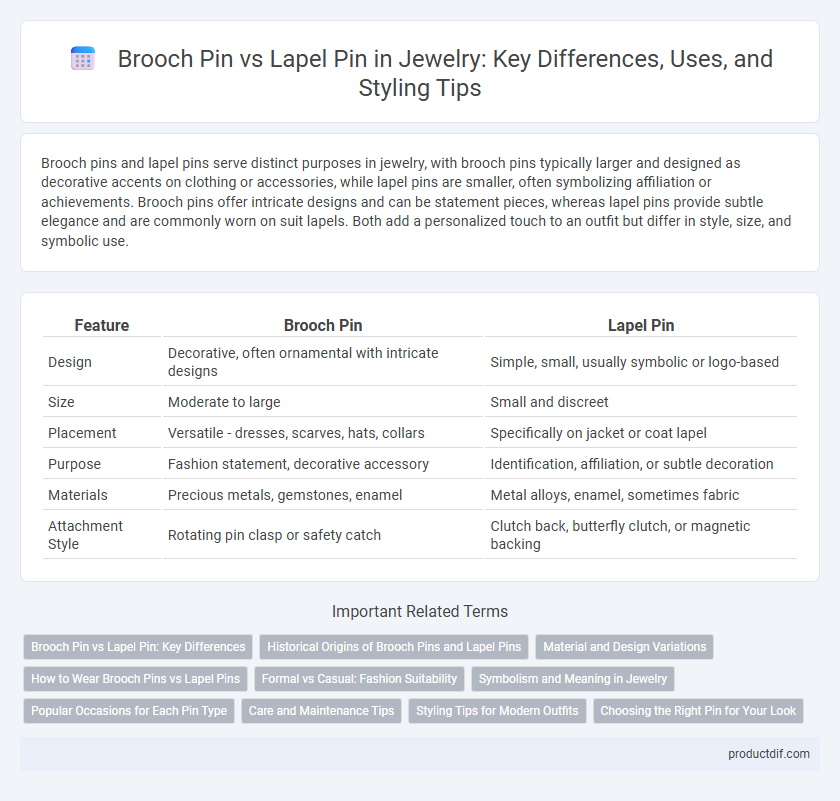Brooch pins and lapel pins serve distinct purposes in jewelry, with brooch pins typically larger and designed as decorative accents on clothing or accessories, while lapel pins are smaller, often symbolizing affiliation or achievements. Brooch pins offer intricate designs and can be statement pieces, whereas lapel pins provide subtle elegance and are commonly worn on suit lapels. Both add a personalized touch to an outfit but differ in style, size, and symbolic use.
Table of Comparison
| Feature | Brooch Pin | Lapel Pin |
|---|---|---|
| Design | Decorative, often ornamental with intricate designs | Simple, small, usually symbolic or logo-based |
| Size | Moderate to large | Small and discreet |
| Placement | Versatile - dresses, scarves, hats, collars | Specifically on jacket or coat lapel |
| Purpose | Fashion statement, decorative accessory | Identification, affiliation, or subtle decoration |
| Materials | Precious metals, gemstones, enamel | Metal alloys, enamel, sometimes fabric |
| Attachment Style | Rotating pin clasp or safety catch | Clutch back, butterfly clutch, or magnetic backing |
Brooch Pin vs Lapel Pin: Key Differences
Brooch pins are typically larger, decorative jewelry pieces designed to fasten clothing or accessories, often featuring elaborate designs with gemstones or intricate metalwork. Lapel pins are smaller, more understated, and traditionally worn on suit lapels to signify affiliations, achievements, or personal style. The primary distinction lies in size, purpose, and design complexity--brooch pins emphasize ornamental appeal while lapel pins prioritize symbolism and subtlety.
Historical Origins of Brooch Pins and Lapel Pins
Brooch pins trace their origins to the Bronze Age, where they functioned as both decorative and utilitarian fasteners for clothing in ancient civilizations like the Celts and Romans. Lapel pins emerged more recently in the 19th century, gaining popularity as emblems of affiliation or political support during European social movements. Both jewelry pieces reflect evolving fashion trends while serving symbolic and practical purposes across history.
Material and Design Variations
Brooch pins often feature intricate designs crafted from precious metals like gold, silver, and platinum, sometimes accented with gemstones or enamel for added elegance. Lapel pins tend to be smaller and simpler, frequently made from metal alloys with enamel fill or printed designs, designed for subtle decoration or branding. Both brooch and lapel pins offer a range of material and design variations, but brooches generally emphasize artisanal craftsmanship and ornamental appeal, while lapel pins focus on versatility and everyday wear.
How to Wear Brooch Pins vs Lapel Pins
Brooch pins are traditionally worn on the chest, often attached to dresses, blouses, or coats to add a touch of elegance and can be positioned to complement necklines or collars. Lapel pins are typically placed on the lapel of a suit jacket or blazer, aligned with the buttonhole for a polished and professional appearance, often signifying affiliation or personal style. Understanding the appropriate placement for each pin enhances their visual impact and ensures they complement the overall outfit.
Formal vs Casual: Fashion Suitability
Brooch pins typically suit formal attire, adding an elegant, decorative touch to dresses, blazers, or evening gowns. Lapel pins are versatile accessories often worn with suits or casual jackets, providing subtle flair or representing affiliations. Understanding the distinct fashion suitability helps select the right pin for occasions, enhancing style with appropriate formality or casual charm.
Symbolism and Meaning in Jewelry
Brooch pins often symbolize elegance and personal expression, traditionally worn as statement pieces that highlight individual style or commemorate significant events. Lapel pins carry strong connotations of affiliation and identity, commonly used to signify membership in organizations, achievements, or support for causes. Both jewelry types convey meaning through design and placement, with brooches emphasizing ornamental value and lapel pins highlighting social or political symbolism.
Popular Occasions for Each Pin Type
Brooch pins are often favored for formal occasions such as weddings and gala events due to their ornate designs and ability to complement elegant attire. Lapel pins are popular at corporate events, conferences, and political gatherings, serving as subtle symbols of affiliation or achievement. Both pin types enhance outfits but are chosen based on the event's dress code and formality.
Care and Maintenance Tips
Brooch pins and lapel pins require gentle cleaning with a soft cloth to maintain their shine and prevent tarnishing. Store them separately in padded jewelry boxes to avoid scratches and damage to delicate materials such as enamel or gemstones. Periodic inspection of clasps and pins ensures secure fastening and prevents loss during wear.
Styling Tips for Modern Outfits
Brooch pins add a bold, decorative touch to modern outfits by accentuating collars, lapels, or even handbags with their distinctive designs, creating focal points that elevate casual or formal looks. Lapel pins, typically smaller and more understated, complement tailored jackets and blazers, offering a subtle yet sophisticated flair that enhances professional or smart-casual ensembles. Pairing brooch pins with monochrome outfits or minimalist styles amplifies their visual impact, while lapel pins work best when matched with classic suits or contemporary outerwear for a refined, polished appearance.
Choosing the Right Pin for Your Look
Brooch pins offer a bold, decorative touch with intricate designs and larger sizes, ideal for statement pieces on dresses or scarves. Lapel pins are smaller and subtler, traditionally worn on suit jackets to convey personal style or brand affiliation. Selecting the right pin depends on the occasion, outfit, and desired impact, with brooch pins suiting formal or artistic looks and lapel pins fitting professional or casual ensembles.
Brooch Pin vs Lapel Pin Infographic

 productdif.com
productdif.com